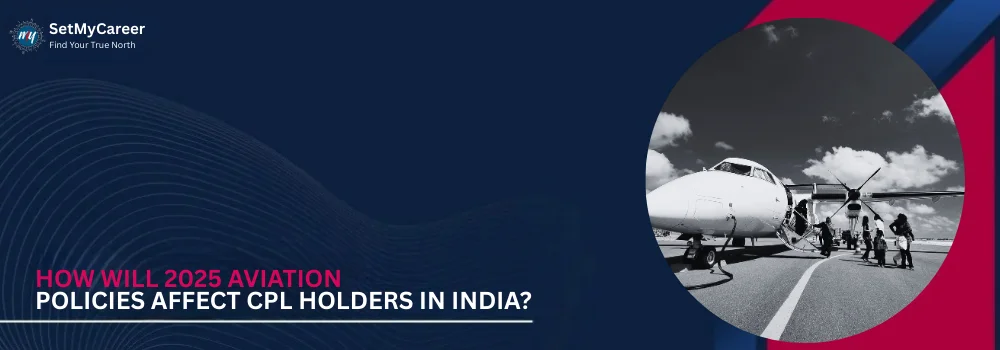
Published by Dr. Nandkishore Rathi on 11 August 2025
Chief Career Navigator
Dr. Nandkishore Rathi is passionate about identifying people's passions and helping them create and lead successful and fulfilling careers. With 30+ years of experience and interactions with thousands of students, academicians, and corporate executives, he has developed a range of career services aimed at benefiting individuals seeking a breakthrough in their professional lives.
In this post, we explore how these regulatory shifts impact CPL holders in India.

Overview of CPL Holders and India’s Aviation Industry,This post will analyze the recent shifts in aviation regulations and their impact on CPL holders in India, with a focus on career prospects, training requirements, and operational changes.
Nothing calms nerves like being prepared. Knowing your content inside and out gives you confidence and reduces the fear of forgetting what to say.
To understand how aviation policy changes affect CPL holders, it's important to recognize the role of the Directorate General of Civil Aviation (DGCA). The DGCA, India’s aviation regulator, sets the standards for pilot training, medical requirements, licensing, and overall flight safety. Any change in regulations—whether related to flight hours, certification, or medical standards—can have a direct impact on CPL holders and their career prospects.
For CPL holders, maintaining a valid license is not enough. Regulatory frameworks require pilots to keep up with specific flight hours, undergo periodic medical tests, and ensure compliance with updated training regulations. The increasing complexity of these standards is influenced by both international safety norms and the government’s vision to position India as a global aviation hub.
India’s aviation market is booming, with air traffic rapidly increasing year after year. The government has set ambitious targets, aiming to make India the third-largest aviation market globally by 2025. The growth in both passenger and cargo traffic directly translates to an increasing need for skilled pilots. This demand is further amplified by new policies and initiatives like the Regional Connectivity Scheme (UDAN) and airline fleet expansions.
Fleet Expansion: Major Indian carriers such as IndiGo, Air India, and Vistara are expanding their fleets and routes. This creates not only more pilot positions but also shifts in hiring patterns,z requiring more specialized pilots who can fly the latest aircraft.
UDAN Scheme: The government’s UDAN scheme aims to connect underserved and unserved airports through affordable air travel. This expansion of regional connectivity has led to the creation of new regional airlines, which significantly increases demand for pilots.
Cargo Sector Boom: E-commerce and logistics are driving growth in the cargo sector, creating a new avenue for CPL holders. Pilots specializing in cargo operations are in demand, as more cargo carriers emerge to meet the logistics needs of the country.
Pilot Retirements: The retirement of senior pilots in both public and private sectors also creates openings for younger, less-experienced CPL holders to step into higher positions. As older pilots reach retirement age, the market has a growing need for fresh talent.

Despite the expanding opportunities, several challenges persist:
High Competition: With the rapid expansion of the aviation sector comes increased competition for pilot positions. Many CPL holders vie for a limited number of spots, particularly in well-established airlines.
Experience Requirements: A major hurdle for new CPL holders is meeting experience requirements. Many airlines prefer pilots with substantial flying hours and experience on specific aircraft types, making it difficult for entry-level CPL holders to land their first jobs.
Financial Burden of Training: Pilot training can cost upwards of several lakhs, leading many CPL holders to graduate with significant debt. Without a high-paying job quickly after certification, managing this financial burden can become a significant stressor.
Airline Financial Health: The financial health of airlines can also pose a risk to career stability. Airlines facing financial difficulties may cut back on hiring or even cease operations, leading to job uncertainty for pilots.
COVID-19 Impact: While the aviation sector is recovering from the impact of the COVID-19 pandemic, disruptions are still felt. Airlines remain cautious in hiring and expanding their fleets, and some routes are yet to return to pre-pandemic levels, which impacts the overall job market.
While the evolving regulatory landscape creates opportunities, it also presents new challenges. The overall growing demand for pilots offers a range of prospects for aspiring aviators:
Regional Aviation: With the UDAN scheme creating regional airlines, CPL holders can find rewarding opportunities in smaller carriers, which may serve as a stepping stone to larger operations. These airlines often offer pilots the chance to gain valuable experience quickly, making it an excellent starting point for building flying hours.
Type-Rated Pilots: As airlines continue to favor pilots who are type-rated (qualified to fly specific aircraft), CPL holders who acquire type ratings on popular aircraft like the Airbus A320 or Boeing 737 have a competitive advantage. This trend can make a significant difference in securing a job, as type ratings reduce airlines' training costs and accelerate the hiring process.
Cargo Sector: The rapid expansion of e-commerce and the rise in air freight demand is creating a boom in the cargo aviation sector. While passenger flights may grab the spotlight, pilots in the cargo sector are increasingly sought after, especially those with specialized training in cargo operations.
Pilot Retirements: The high retirement rate of senior pilots, especially from large airlines, is creating positions at higher levels. "Also Read How to become a commercial pilot".
Several key trends are shaping the aviation industry and the careers of CPL holders:
Increased Demand for Type-Rated Pilots: Airlines are increasingly preferring pilots who are already type-rated, reducing training time and costs. This trend is crucial for CPL holders aiming to get hired quickly.
Focus on Competencies and Skills: Airlines are placing greater emphasis on assessing a pilot's overall skill set. Technical knowledge,decision-making ability, and interpersonal skills are now critical during interviews and simulator assessments.
Opportunities in Regional Aviation: The UDAN scheme has created opportunities in regional aviation, allowing CPL holders to gain flying experience quickly. These smaller regional airlines often provide flexible pathways for career advancement.
India’s aviation sector offers significant opportunities for CPL holders, but it also comes with challenges. Staying informed, improving skills, and adapting to industry trends are key to success. Additionally, career counselling can provide crucial guidance, helping pilots make informed decisions, build experience, and navigate the competitive job market. With the right support and a proactive approach, CPL holders can thrive in India’s growing aviation industry.
No. 14/595, 1st Floor, Nanjappa Reddy Layout, Koramangala 8th Block, Bangalore 560095